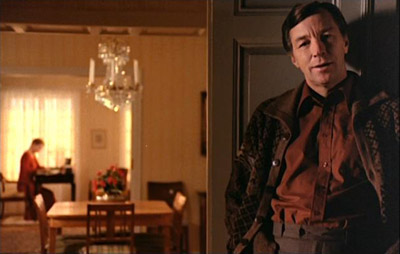It's in the Eyes and the Angles
 Ingmar Bergman's Autumn Sonata opens with a man talking about his wife. That man, Viktor, tells of how he and Eva became married and of some of her flaws and problems when it comes to dealing with emotions. He speaks directly to the camera before becoming part of the scene and ignoring the camera until the very end of the film.
Ingmar Bergman's Autumn Sonata opens with a man talking about his wife. That man, Viktor, tells of how he and Eva became married and of some of her flaws and problems when it comes to dealing with emotions. He speaks directly to the camera before becoming part of the scene and ignoring the camera until the very end of the film.At first, his breaking of the 4th wall may seem an odd way to open the movie, especially being that the movie is so heavy on emotion and dialogue between characters and Viktor's interaction with the audience seems to distance you from the film you are about to see. But what the absent 4th wall actually does, just for those few seconds, is give you an extremely effective false sense of control. Bergman let's you think you have the upper hand in what will become a heart wrenching battle between Liv Ullman and Ingmar's namesake, and Ullman's on screen mother, Ingrid Bergman.
The battle is also one in which both women come into thinking they also have the upper hand. Liv Ullman's Eva comes thinking she has outgrown her past. She is a quiet woman, but from the moment she speaks of her mother, it's clear she is seeking approval from her. Ingrid Bergman's Charlotte, a woman who sacrificed her family to pursue her career as a pianist, comes thinking she will be able to give Eva what she needs, but from the second we meet her, it becomes clear she doesn't know how to provide her daughter with anything she needs, despite good intentions and a desire to be a better mother.
 The films follows intimate moments with the women, on their own and together as they somewhat unknowingly move towards a venting session like only Bergman could create. Eva's personal battle to forgive and Charlotte's personal battle to balance her ambition with her family have long been pent up inside each of the women, and when all is said and done, neither is any more to blame than the other. Bergman and Ullman give us honest women, who in keeping true to themselves have failed each other.
The films follows intimate moments with the women, on their own and together as they somewhat unknowingly move towards a venting session like only Bergman could create. Eva's personal battle to forgive and Charlotte's personal battle to balance her ambition with her family have long been pent up inside each of the women, and when all is said and done, neither is any more to blame than the other. Bergman and Ullman give us honest women, who in keeping true to themselves have failed each other.It's been said that Autumn Sonata is more like a piece of theater than a film, but that would mean ignoring two of the things that make Autumn Sonata what it is, the colors and camera. Like the title would suggest, everything is bathed in red, orange and yellow lights and hues. It gives a false sense of warmth to the piece, not unlike the false sense of warmth both women have crafted in regards to their reunion. What makes this a movie though, is the camera. Bergman holds on his actors, holds on their faces, lets their expression tell the story. He centers in on them in a way a piece of theater never could. The perfect example of this is below, there are no subtitles, but you don't need them:


No comments:
Post a Comment